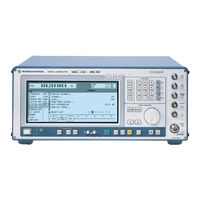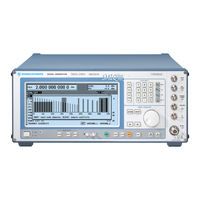User Manuals: Rohde & Schwarz SMIQ03B Generator
Manuals and User Guides for Rohde & Schwarz SMIQ03B Generator. We have 3 Rohde & Schwarz SMIQ03B Generator manuals available for free PDF download: Operating Manual
Rohde & Schwarz SMIQ03B Operating Manual (516 pages)
VECTOR SIGNAL GENERATOR
Brand: Rohde & Schwarz
|
Category: Portable Generator
|
Size: 4.48 MB
Table of Contents
-
Section 1
24 -
Section 2
38-
Display70
-
Operation70
-
List Editor101
-
Edition of Lists104
-
Menu Summary113
-
RF Frequency114
-
Frequency Offset115
-
RF Level116
-
Level Offset118
-
Emf122
-
RF on / OFF]-Key123
-
LF Generator126
-
MOD ON/OFF] Key127
-
Preemphasis131
-
Phase Modulation132
-
Pulse Modulation134
-
I/Q Impairment138
-
Menu FADING SIM141
-
Menu FINE DELAY147
-
Menu BIRTH-DEATH152
-
Test Procedure154
-
Coding158
-
FSK Modulation158
-
Envelope Control168
-
Clock Signals169
-
Menu WCDMA/3GPP248
-
Ideal Scenario299
-
Real Scenario299
-
Effect of SCH300
-
Test Setup305
-
Downlink309
-
Channel Coding312
-
Uplink322
-
OCNS Channels326
-
OCNS Menu326
-
GPS Menu404
-
Function410
-
Use of Winiqsim413
-
ARB MOD Menu414
-
Arb Mod - Clock423
-
Operating Menu438
-
Test Method443
-
PRBS Polynomials444
-
Operating Menu447
-
CRC Polynomial449
-
LF Output460
-
Sweep461
-
Sweep Outputs463
-
Trigger Input463
-
RF Sweep465
-
LEVEL Sweep467
-
LF Sweep468
-
LIST Mode470
-
Inputs/Outputs471
-
Memory Sequence475
-
Utilities479
-
Test (TEST)496
-
Status501
-
The Help System501
-
Error Messages502
Advertisement
Rohde & Schwarz SMIQ03B Operating Manual (408 pages)
VECTOR SIGNAL GENERATOR
Brand: Rohde & Schwarz
|
Category: Portable Generator
|
Size: 1.5 MB
Table of Contents
-
IEC-Bus30
-
Interface31
-
Messages33
-
Parameter38
-
Notation41
-
Abort System46
-
ARB System47
-
BERT System59
-
BLER System63
-
Source2 System223
-
Status System228
-
System System230
-
TEST System236
-
Trigger System239
-
UNIT System243
-
Input Unit244
-
Output Unit246
-
Test Assemblies263
-
Test Procedures269
-
Frequency269
-
Settling Time270
-
Level273
-
Output Impedance275
-
Settling Time276
-
Spectral Purity279
-
Harmonics279
-
Subharmonics280
-
Nonharmonics280
-
Broadband Noise283
-
SSB Phase Noise284
-
Residual FM285
-
Residual am285
-
Sweep285
-
Maximum Level287
-
Error Vector288
-
I/Q Imbalance290
Rohde & Schwarz SMIQ03B Operating Manual (407 pages)
VECTOR SIGNAL GENERATOR
Brand: Rohde & Schwarz
|
Category: Portable Generator
|
Size: 1.37 MB
Table of Contents
-
IEC-Bus29
-
Interface30
-
Messages32
-
Parameter37
-
Notation40
-
Abort System45
-
ARB System46
-
BERT System58
-
BLER System62
-
Source2 System222
-
Status System227
-
System System229
-
TEST System235
-
Trigger System238
-
UNIT System242
-
Input Unit243
-
Output Unit245
-
Test Assemblies262
-
Test Procedures268
-
Frequency268
-
Settling Time269
-
Level272
-
Output Impedance274
-
Settling Time275
-
Spectral Purity278
-
Harmonics278
-
Subharmonics279
-
Nonharmonics279
-
Broadband Noise282
-
SSB Phase Noise283
-
Residual FM284
-
Residual am284
-
Sweep284
-
Maximum Level286
-
Error Vector287
-
I/Q Imbalance289
Advertisement


